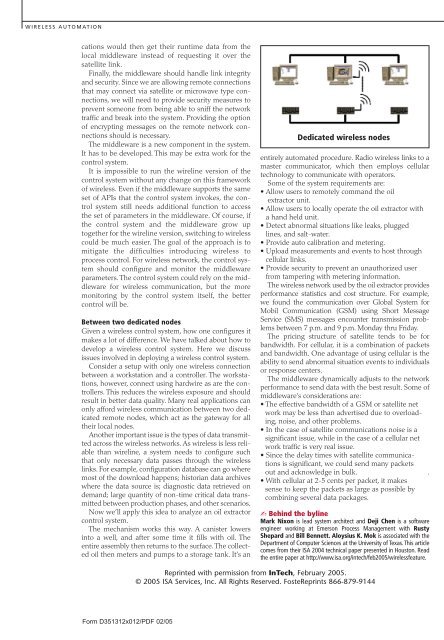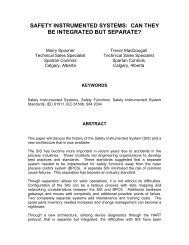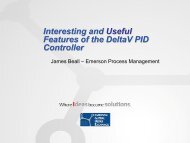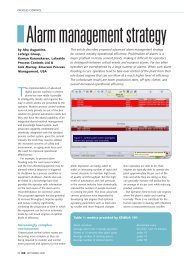Process Control Adopts Wireless - Emerson Process Experts
Process Control Adopts Wireless - Emerson Process Experts
Process Control Adopts Wireless - Emerson Process Experts
You also want an ePaper? Increase the reach of your titles
YUMPU automatically turns print PDFs into web optimized ePapers that Google loves.
WIRELESS AUTOMATIONcations would then get their runtime data from thelocal middleware instead of requesting it over thesatellite link.Finally, the middleware should handle link integrityand security. Since we are allowing remote connectionsthat may connect via satellite or microwave type connections,we will need to provide security measures toprevent someone from being able to sniff the networktraffic and break into the system. Providing the optionof encrypting messages on the remote network connectionsshould is necessary.The middleware is a new component in the system.It has to be developed. This may be extra work for thecontrol system.It is impossible to run the wireline version of thecontrol system without any change on this frameworkof wireless. Even if the middleware supports the sameset of APIs that the control system invokes, the controlsystem still needs additional function to accessthe set of parameters in the middleware. Of course, ifthe control system and the middleware grow uptogether for the wireline version, switching to wirelesscould be much easier. The goal of the approach is tomitigate the difficulties introducing wireless toprocess control. For wireless network, the control systemshould configure and monitor the middlewareparameters. The control system could rely on the middlewarefor wireless communication, but the moremonitoring by the control system itself, the bettercontrol will be.Between two dedicated nodesGiven a wireless control system, how one configures itmakes a lot of difference. We have talked about how todevelop a wireless control system. Here we discussissues involved in deploying a wireless control system.Consider a setup with only one wireless connectionbetween a workstation and a controller. The workstations,however, connect using hardwire as are the controllers.This reduces the wireless exposure and shouldresult in better data quality. Many real applications canonly afford wireless communication between two dedicatedremote nodes, which act as the gateway for alltheir local nodes.Another important issue is the types of data transmittedacross the wireless networks. As wireless is less reliablethan wireline, a system needs to configure suchthat only necessary data passes through the wirelesslinks. For example, configuration database can go wheremost of the download happens; historian data archiveswhere the data source is; diagnostic data retrieved ondemand; large quantity of non-time critical data transmittedbetween production phases, and other scenarios.Now we’ll apply this idea to analyze an oil extractorcontrol system.The mechanism works this way. A canister lowersinto a well, and after some time it fills with oil. Theentire assembly then returns to the surface.The collectedoil then meters and pumps to a storage tank. It’s anDedicated wireless nodesentirely automated procedure. Radio wireless links to amaster communicator, which then employs cellulartechnology to communicate with operators.Some of the system requirements are:• Allow users to remotely command the oilextractor unit.• Allow users to locally operate the oil extractor witha hand held unit.• Detect abnormal situations like leaks, pluggedlines, and salt-water.• Provide auto calibration and metering.• Upload measurements and events to host throughcellular links.• Provide security to prevent an unauthorized userfrom tampering with metering information.The wireless network used by the oil extractor providesperformance statistics and cost structure. For example,we found the communication over Global System forMobil Communication (GSM) using Short MessageService (SMS) messages encounter transmission problemsbetween 7 p.m. and 9 p.m. Monday thru Friday.The pricing structure of satellite tends to be forbandwidth. For cellular, it is a combination of packetsand bandwidth. One advantage of using cellular is theability to send abnormal situation events to individualsor response centers.The middleware dynamically adjusts to the networkperformance to send data with the best result. Some ofmiddleware’s considerations are:• The effective bandwidth of a GSM or satellite network may be less than advertised due to overloading,noise, and other problems.• In the case of satellite communications noise is asignificant issue, while in the case of a cellular network traffic is very real issue.• Since the delay times with satellite communicationsis significant, we could send many packetsout and acknowledge in bulk. .• With cellular at 2-5 cents per packet, it makessense to keep the packets as large as possible bycombining several data packages.✍ Behind the bylineMark Nixon is lead system architect and Deji Chen is a softwareengineer working at <strong>Emerson</strong> <strong>Process</strong> Management with RustyShepard and Bill Bennett. Aloysius K. Mok is associated with theDepartment of Computer Sciences at the University of Texas. This articlecomes from their ISA 2004 technical paper presented in Houston. Readthe entire paper at http://www.isa.org/intech/feb2005/wirelessfeature.Reprinted with permission from InTech, February 2005.© 2005 ISA Services, Inc. All Rights Reserved. FosteReprints 866-879-9144Form D351312x012/PDF 02/05






